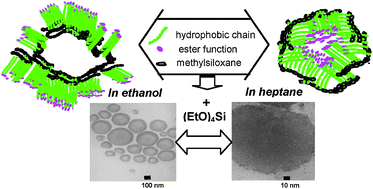Nanocomposites from natural templates based on fatty compound-functionalised siloxanes†
Abstract
This work describes the synthesis of new, environmentally friendly, robust and biocompatible organic–inorganic hybrid materials based on

* Corresponding authors
a
Matériaux Avancés pour la Catalyse et la Santé, « MACS », Institut Charles Gerhardt, UMR 5253 CNRS/ENSCM/UM2/UM1, 8 rue de l'Ecole Normale, 34296 Montpellier, Cedex 5, France
E-mail:
daniel.brunel@enscm.fr, abdelkrim.elkadib@enscm.fr
Fax: +33(0)4 67 16 3470
Tel: +33(0)4 67 16 3446
b
Laboratoire d'Hétérochimie Fondamentale et Appliquée, UMR-CNRS 5069, Université Paul Sabatier, 118 Route de Narbonne, 31062 Toulouse, Cedex 9, France
Fax: +33(0)5 61 55 8204
This work describes the synthesis of new, environmentally friendly, robust and biocompatible organic–inorganic hybrid materials based on

 Please wait while we load your content...
Something went wrong. Try again?
Please wait while we load your content...
Something went wrong. Try again?
A. El Kadib, N. Katir, N. Marcotte, K. Molvinger, A. Castel, P. Rivière and D. Brunel, J. Mater. Chem., 2009, 19, 6004 DOI: 10.1039/B906448F
To request permission to reproduce material from this article, please go to the Copyright Clearance Center request page.
If you are an author contributing to an RSC publication, you do not need to request permission provided correct acknowledgement is given.
If you are the author of this article, you do not need to request permission to reproduce figures and diagrams provided correct acknowledgement is given. If you want to reproduce the whole article in a third-party publication (excluding your thesis/dissertation for which permission is not required) please go to the Copyright Clearance Center request page.
Read more about how to correctly acknowledge RSC content.
 Fetching data from CrossRef.
Fetching data from CrossRef.
This may take some time to load.
Loading related content
